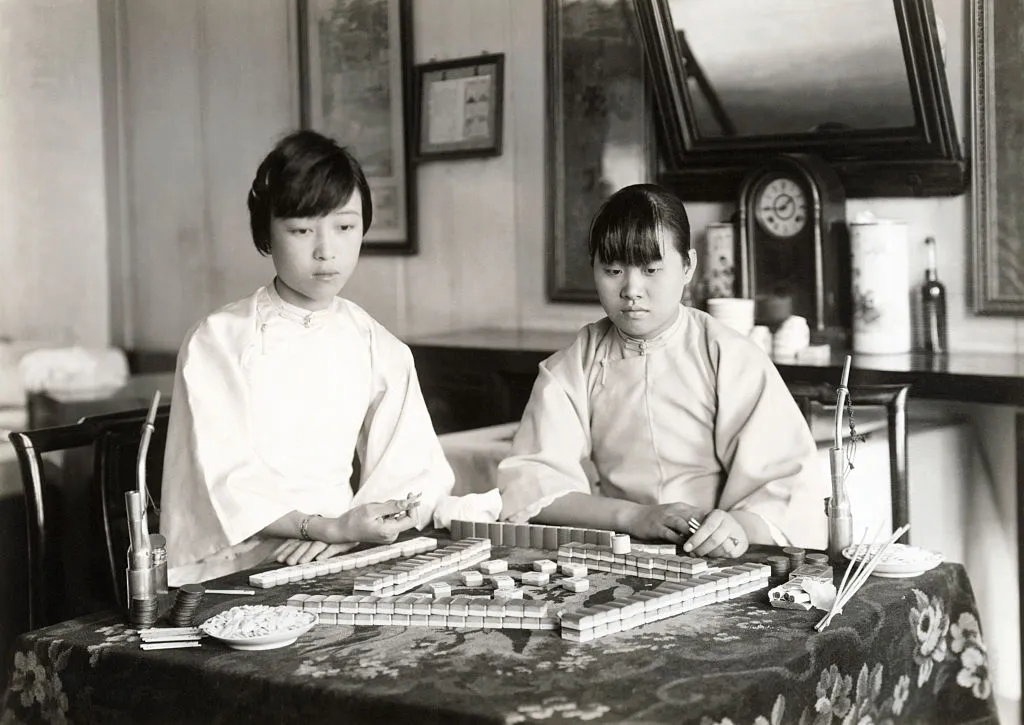*Two Chinese girls playing mah-jongg, circa 1920s Bettmann Archive—Getty Images
Step into a lively tea house in 1920s Shanghai—jasmine swirling in the air, quiet chatter buzzing at every table, and the crisp clack of Mahjong tiles cutting through it all. Players lean in, murmuring strategies over tiny porcelain cups, every move calculated, every glance deliberate.
Now jump ahead a hundred years—the tiles are still clacking, but now it’s in brightly lit convention centers from Las Vegas to Tokyo. The teacups? Swapped for scoring sheets and serious game faces. The spirit, though? Still very much the same.
Mahjong’s journey from family parlors to global championships isn’t just about rules and trophies—it’s a story of how a centuries-old game outran tradition to become a battleground for sharp minds.
Let’s unravel how this cultural gem morphed into a sport where grandmas and Gen Z gamers clash over dragons and bamboos.
The Cultural Roots: Where Mahjong Began Its Quiet Revolution
Long before leaderboards and prize money, Mahjong was the soundtrack to Chinese family life. Picture the Qing Dynasty’s twilight years: scholars huddled over hand-carved tiles, merchants unwinding after haggling deals, and Lunar New Year celebrations where generations bonded over whispered strategies.
The game was a social glue, steeped in symbols like the “Red Dragon” tile, rumored to represent imperial power.
But Mahjong never stayed put. Like a culinary recipe passed through migrants, it mutated as it traveled. In Cantonese ports, players added faster-paced rules to match the cities’ bustle. Jewish immigrants in 1920s New York tweaked it into “Mah-Jongg,” complete with card-based scoring that baffled purists.
This chameleon-like adaptability kept it alive. Families might’ve argued over regional rules, but the heart of the game—the thrill of a winning hand—remained universal.
From Kitchen Tables to Scorecards: When Play Got Serious
For decades, Mahjong was the background music of social life—until ambition turned up the volume. The mid-20th century saw rulebooks thicker than dictionaries, as players craved structure. Imagine aunties who once played for bragging rights suddenly debating if a “Nine Gates” hand deserved 88 or 100 points. This wasn’t just nitpicking; it was the birth of a sport.
By the 1970s, clubs in Tokyo and Hong Kong started hosting “friendly” matches with actual judges. The stakes were low—maybe a silk scarf or braised pork buns—but the shift was seismic. Players realized strategy could be honed, not just inherited. A farmer’s son could outplay a professor if he mastered tile probabilities. The game was democratizing, one organized match at a time.
Landmark Moments: Tournaments That Changed the Game
The 1980s blew the roof off. In 1984, Osaka hosted what many call the first true Mahjong championship. Picture a room of chain-smoking salarymen, slide rules in hand, calculating scores with the intensity of Wall Street traders. Winners didn’t just get cash—they earned ranking points that sparked regional rivalries.
Then came 2002’s atomic moment: the inaugural World Mahjong Championship in Tokyo. Suddenly, Americans in baseball caps faced off against Chinese pros who’d trained since childhood. The rules? A hybrid system to level the playing field. A Dutch nurse stunned everyone by placing third, proving Mahjong wasn’t Asia’s secret anymore.
Going Global: When Mahjong Became the World’s Game
Post-2002, the floodgates opened. Paris cafés hosted “Mahjong Mondays,” while Las Vegas casinos added tile tournaments alongside poker. The game’s appeal? It’s chess with a dash of luck—a retiree could bluff her way past a math whiz.
But the real magic was cultural cross-pollination. At the 2010 European Championship, a Swedish player used a strategy borrowed from Sichuan farmers. A Nigerian teen qualifier in 2018 mixed Cantonese tactics with her love of probability math. The tiles hadn’t changed, but the players turned Mahjong into a language everyone spoke.
Tomorrow’ Tiles: Tech, Teens, and the New Era
Today’s Mahjong champs are as likely to stream on Twitch as shuffle physical tiles. Apps like Mahjong Soul have millions logging in daily, battling AI or strangers in Lagos. But it’s not just pixels—the game’s soul survives.
Leagues now court Gen Z with anime-themed tile sets and shorter “speed Mahjong” formats. Meanwhile, the World Championship has added youth divisions and AI-assisted training tools. Yet at its core, the thrill remains: that heartbeat pause before flipping a tile, the gasp when a hidden hand emerges.
The Unbroken Thread: Why Mahjong Endures
From Qing Dynasty courtyards to esports arenas, Mahjong’s secret isn’t in its rules but its humanity. It’s a game where memory collides with chance, where tradition shakes hands with innovation. Every championship winner still uses tactics their great-grandmother might recognize—even if she’d frown at their hashtag-heavy victory speech.
As long as families gather and rivals hunger for glory, those 144 tiles will keep spinning stories. The next chapter? Maybe your name on a trophy, or a live-streamed match uniting continents. The game’s ready—are you?

